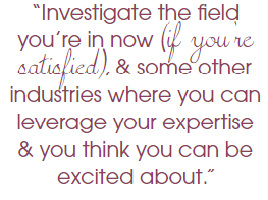Baby Boomers are living longer, retiring later and, the truth is, we’re finding that one lifelong career just isn’t enough. Long gone are the days when a high school or college graduate finds a dream job, spends the next 30-35 years moving up the company ladder and retires with a pension at 62. In fact, graduates are changing jobs nearly three times, on average, within the first five years of graduation; a pace that has nearly doubled versus just 20 years ago, according to LinkedIn Economic Graph data.
Whether you’re a Millennial, Baby Boomer or somewhere in between, if you’ve spent any time in real estate or financial services over the past five to 10 years, chances are you’ve experienced long and lean times as a regular course of doing business. With the ongoing interest rate movement and uncertain times ahead, there is no better time than now to consider where you stand in your career, how much it fulfills you and what might lie ahead.

My own employment, some 30 years of trials and successes in financial services, has taken me over a lot of winding roads. I’ve had to make a number of adjustments to my career path—either preemptive or forced—most recently several years ago when my employer (a very large and well-established insurer in the mortgage banking ecosystem) descended into receivership.
As with twists and turns I’d experienced before, the writing had been on the wall. Banks were substantially cutting back from residential lending and servicing. The once robust non-agency market was anemic and unlikely to emerge as its former self. Warehouse lending, title services, mortgage insurance, appraisal services and others survived, but were (and are) very competitive commoditized value propositions that expand and contract based on market need.
Fortunately for me, I had diversified jobwise. Since 2005 I had been following a passion and teaching evening college classes in finance and macroeconomics. So while the sudden change stung, it didn’t sink me.
As both a student and professor, I’ve spent a lot of time studying employment trends. Virtually every generation has faced changes in both opportunity and employment requirements due to advances in technology. In real estate and mortgage lending, automation of workflow has been a driver of technology in loan originating, appraisal, loan processing, underwriting, servicing, brokerage services segments and much more. I had been exploring how to capitalize on my 30+ years of mortgage banking, structured finance and capital markets experience to refresh my career. My research led me to financial technology companies that were quietly making inroads into the space, but with improved value propositions.
Shortly after things went south with my employer, I accepted a position at a fintech company in San Francisco called Alight. It was a leap for me—I was a died-in-the-wool mortgage guy and while Alight was exciting, I have to admit to having a bit of trepidation about becoming a tech sales guy. But I was hooked from the start. Alight’s value proposition suited my expertise, my educational background and my view of where the mortgage industry needed to head. It was a win-win for me from day one to the end of my time at the company.
Back to you. Chances are your industry—your livelihood—is (or will be) undergoing substantive change, change that will likely affect the way things run. You need to be prepared for any surprises that may come your way. But where to start?

1. Do your research.
First, study the advancement of tech companies and the
inroads they made during periods of change. Tech advancements are the proverbial writing on the wall and typically herald significant change coming. Technology that enhances productivity may curb manpower needs, while technology that opens up new areas previously undiscovered may require additional manpower, so education and training—even just some self-study—may be necessary. Investigate the field you’re in now (if you’re satisfied), and some other industries where you can leverage your expertise and about which you think you can be excited.
2. Take the five-year plan and stay relevant.
Use your imagination to consider where the industry might be five years from now; it’s a reasonable and practical timeframe on which to base decisions. Read thought leaders and influencers, not only in your industry but also in related industries and broad, innovative areas like technology, sciences, economics. And then, instead of focusing on the job you would like to have five years from now, begin by considering what types of employment will be part of the future economy. Play to your strengths, your experience and your skillsets, and educate yourself in unfamiliar areas that have potential. Be sure to only pursue things that excite you and will be worth really working for.
3. Get in touch & stay in touch.
If you’ve been working in an industry for a while, you’ve likely accumulated a lot of contacts. Take the time to reconnect with old colleagues as those contacts will come in handy as you look for new opportunities. Begin to grow your network out beyond the borders of your industry, particularly into areas you are exploring. People like to refer and hire people they know.
4. Find your paper route.
Develop a hobby, passion, talent or value proposition into a business that is economically rewarding, convenient timewise and psychologically liberating. Start it as a paper route, something you do in your spare time that can add a second or third source of regular and predictable incremental income. Your paper route may start off small, but with time and energy you can grow it into a meaningful source of income. Get certified or licensed, and keep it active. When I first started teaching 12 years ago, what I made was laughable. I taught one class and earned $400 for an eight-week session, and today I am an adjunct professor. My teaching income is not inconsequential and the benefits are substantive. Best of all, I love teaching and it is something that I can do well into semi-retirement.
5. Develop an achieveable, but not too slow timeline.
Life is busy and there are a million things that can get in the way of making changes, particularly when it comes to revamping a career. It’s much easier to continue on the same trajectory than to change course. Take a breath and reevaluate. The things you start today, the things that require extra effort, the things that require a journey, are the very things that will contribute to your success sometime in the future. I once had a boss who always said to me, “Ralph, the only way to eat an elephant is one bite at a time.” Well, go ahead and take that first bite.
Expanding your career into a new area or converting a hobby into an income-producing enterprise requires a lot of care and feeding, a whole lot of discipline and some sacrifice. But, once you’ve done it, you won’t remember the pain, you’ll be basking in the rewards. Things like supplemental income, or a “side hustle,” as the Millennial demographic calls it, can turn into a meaningful addition to your personal bottom line. Money is fungible, $3,000 to $25,000 per year in extra cash can be very additive to lifestyle, savings or whatever you decide.

Start thinking about what may lie ahead for you—life’s big milestones—kids, houses, weddings, college, rainy days, retirement—and factor those into your plan first. Once you have those cornerstones laid, the only limits to what comes next are the ones you impose. Live your best life many times!
Ralph Armenta
Technology and Mortgage Banking Consultant & Adjunct Finance Marcoeconomics Professor

 Login
Login

